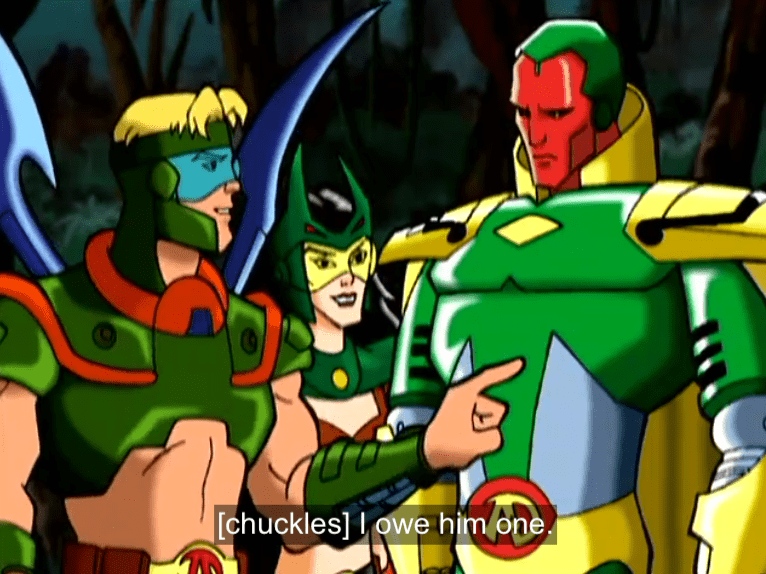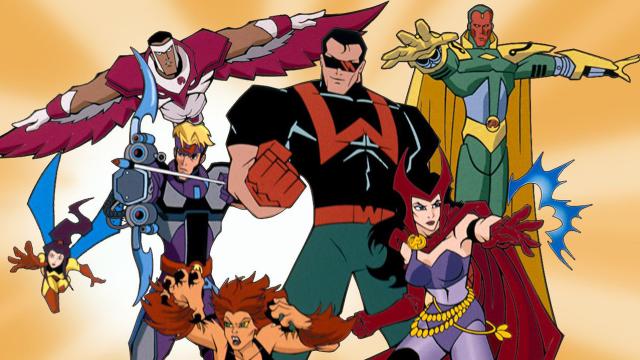Marvel’s live-action adaptations of its classic comics storylines have become the studio’s bread and butter since the inception of the Marvel Cinematic Universe (which are all currently available to watch on Disney+). But for decades, Marvel channeled an inordinate amount of energy into animated offerings squarely aimed at children with the obvious intention of selling vast sums of gaudy action figures.
Urging children to pester their parents into buying toys based on cartoon shows is nothing new. By the time The Avengers: United They Stand debuted in 1999, the practice was already standard for giants in the genre entertainment industry. But the Fox Kids animated series came at an inflection point in Marvel’s history just as the company was beginning to recover from a near-collapse and filing for Chapter 11 bankruptcy, and shortly before films like Fox’s X-Men put Marvel’s cinematic properties onto the big screen in a major way.
United They Stand was very much a product of the ‘90s that incorporated stylistic and narrative elements from X-Men: The Animated Series, the Spider-Man animated series, and the Silver Surfer series to name a few. It also gave its audience the tiniest of glimpses of the kind of wild storytelling that would, in time, come to surprise viewers as it became an important part of the MCU’s take on some of Marvel’s most iconic heroes. Unlike most all of Marvel’s present-day incarnations of the Avengers, United They Stand made the bold decision to steer clear of core heroes like Captain America, Iron Man, Black Widow, and Thor in favour of characters who were every bit as integral to the Avengers’ brand in Marvel’s comics but, for a variety of reasons, are only just now getting the major live-action treatment that puts them front and centre.
In this telling, founding Avengers members Ant/Giant-Man and Wasp work with the Scarlet Witch, Tigra, Wonder Man, and a very belligerent Hawkeye to protect the world from a variety of threats. The American government doesn’t like the way they go about it but tolerates them out of pure necessity. Though the Avengers are famous heroes as the series begins, the prospect of heading up the team terrifies Hank Pym who, much like his comics counterpart, is a man haunted by personal demons — including a deep-seated insecurity about his leadership skills and a kind of inferiority complex stemming from the time he spent taking orders from Captain America.
By decentering the Avengers’ “stars,” United They Stand gave itself space to actually flesh out the interiority of its central characters in ways that felt thoughtful and, surprisingly, did a solid job of bringing some of Marvel’s more convoluted comics plots to a much broader audience. As Avengers go, Wonder Man’s always ranked somewhat low on the list of characters given all that much time in the spotlight, in part because Simon Williams hasn’t exactly been the most compelling character outside of his complicated relationships with Wanda Maximoff and the Vision.
Early into United They Stand’s first and only season, the show picks up with an Ultron-focused arc in which the heroes do battle with Pym’s robotic creation, only to have their asses summarily handed to them as Ultron sets out on a campaign to conquer Earth. One would imagine that a villain like Ultron would bring all of the Avengers out of the woodwork — including those like Black Panther, Beast, and Quicksilver who are all acknowledged within the show, but never featured — but instead United They Stand’s team attempts to make a go of it on their own, leading to Wonder Man being critically injured and left in a coma-like state.
In Marvel’s comics, the Vision’s origins are…complicated to say the least, as it involves the very mechanical Human Torch, Ultron, and a bit of what might as well be mind-swapping all adding up to a story that doesn’t exactly lend itself to any sort of sensical straightforward adaptation. United They Stand, though, does a surprisingly solid job of establishing specifically how Vision and Wonder Man are, in a sense, related in such a way that lays the groundwork for Wanda and Vision’s eventual romance and pushes them to reflect on what it means to be a living “person.”
Vision eventually joining the team brings out the best and worst in his new allies — like Hawkeye, who the show goes to great lengths to frame as a gruff, badass Wolverine type despite the fact that he’s the only member of the team with no true superpowers. Where Wanda saw Wonder Man as a potential love interest, Hawkeye saw him as a brother, and the idea of losing Simon only further pushes Hawkeye to act on his violent, rageful instincts that at one point lead to him being kicked off the team.

As often as the Avengers ended up venturing off into distant jungles to fight techno-organic robots or into space to battle Marvel’s rarely-used villainous Zodiac, United They Stand maintained a sort of emotional edge that gave its characters just enough intensity to let you know that they were all people dealing with the weight of their collective superheroic responsibilities. At the same time, however, it was also very much a ‘90s Cartoon™. Almost everything about its depictions of the Avengers was designed to make you want to buy toys so that you could recreate each episode’s ridiculousness from the comfort of your home using a little bit of imagination.
At some point during each episode when the Avengers were pulled into a fight, each of them underwent a magical girl-like transformation sequence that resulted in them wearing chunky, unsightly armour that served little functional purpose other than to let you know that they were about to throw down. Different settings often required the plot to outfit its heroes in “specialised” armour that was clearly meant to create even more merchandise to push.
Generally so-so as The Avengers: United They Stand’s writing tended to be, the series had a beating heart beneath its numerous layers of corporate strategising, and unsurprisingly, the show definitely works as an unintended comedy when you compare it to what Marvel’s doing with these same characters now. It’s highly unlikely that going back to watch the series now would provide you with any insight as to what the future of the MCU might hold, but at the very least, it’s an enjoyably silly and blessedly short blast from the past that you can plow through in a weekend, all the while chuckling to yourself about how far the Avengers have come.
Avengers: United They Stand is available to stream on Disney+. You can sign up to Disney+ here.

Comments